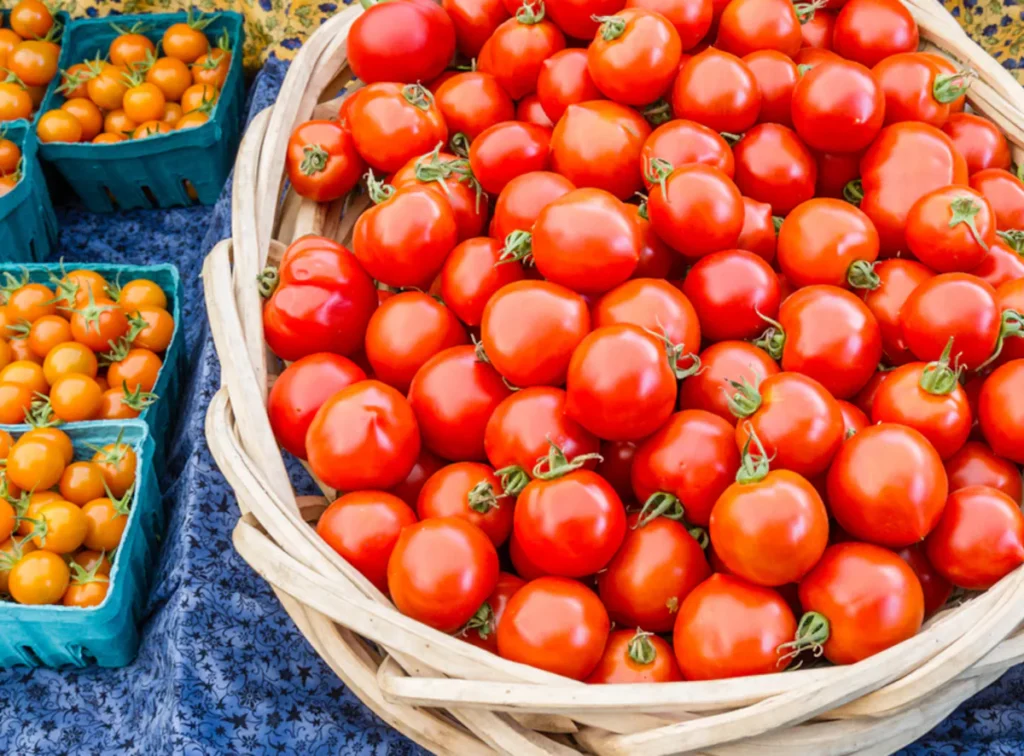Cherry tomatoes are delightful fruit that may be preserved for a long time by dehydrating them. Dehydrating cherry tomatoes is a quick and efficient technique to preserve their bright flavor whether you have an excess of them from your garden or want to use them all year long.
The inherent sweetness of the tomatoes may be concentrated, and their shelf life can be extended by eliminating the moisture from them. The procedure for dehydrating cherry tomatoes, together with the essential procedures, tools, and advice for getting the best results, will be covered in this article.
Also Read: Best Apples for Juicing
Dried Cherry Tomatoes – Benefits
Due to their concentrated vitamin content and distinctive flavor, dried cherry tomatoes have several advantages. The advantages of dried cherry tomatoes are outlined below in bullet points:
- Lycopene, beta-carotene, and vitamin C are antioxidants abundant in dried cherry tomatoes. These antioxidants aid in the body’s defense against free radicals, which can harm cells and play a part in chronic illnesses, including cancer and heart disease.
- Cherry tomatoes become a more concentrated source of nutrients when they are dried since the water content is removed. Fresh tomatoes have higher concentrations of vitamins, minerals, and phytonutrients than fresh tomatoes. Potassium, vitamin K, vitamin A, and numerous B vitamins are among them.
- Drying cherry tomatoes greatly increases their shelf life compared to fresh cherry tomatoes. Thus, They are a practical choice for individuals who wish to benefit from the flavor and health advantages of tomatoes all year long without worrying about deterioration.
- Dried cherry tomatoes are a versatile item that may be utilized in various cuisines. They provide salads, pasta dishes, sandwiches, and other foods with potent tomato flavor. They also function well on their own as a portable and healthy snack.
- Dietary fiber may be found in dried cherry tomatoes, which is crucial for preserving a healthy digestive tract. Fiber aids overall gut health by regulating bowel motions, preventing constipation, and preventing diarrhea.
- Dried cherry tomatoes have fewer calories than other snack alternatives like chips or cookies. They are, therefore, a better option for people trying to control their weight or cut back on calories.
- Dried cherry tomatoes’ high beta-carotene content benefits the eyes’ health. In the body, beta-carotene is transformed into vitamin A, necessary for preserving excellent vision and avoiding age-related macular degeneration.
- A robust immune system is supported by dried cherry tomatoes’ antioxidants, vitamins, and minerals. In particular, vitamin C is essential for boosting immunity and guarding against common infections.
- Heart disease risk has been linked to the lycopene content of dried cherry tomatoes. Lycopene supports cardiovascular health by lowering blood pressure and LDL cholesterol levels and preventing LDL cholesterol from oxidizing.
- The intense umami flavor of dried cherry tomatoes gives food richness and depth. Umami is frequently called savory or meaty and is considered the fifth taste experience.
Cherry Tomato Varieties
Small, bite-sized cherry tomatoes are renowned for their sweet and tart flavor. Cherry tomatoes come in several different types, each with unique qualities. The “Sweet 100,” a well-liked cultivar, yields abundant petite, red, wonderfully delicious fruits. Another popular kind is “Sun Gold,” which has a vivid orange color and a delightful tropical flavor. The “Black Cherry” cultivar distinguishes out thanks to its rich, smokey flavor and deep purple color. These are only a handful of the numerous cherry tomato types offered, each providing a distinctive flavor and look to accommodate diverse gastronomic tastes.
The Best Tomatoes For Dehydrating

Certain tomato varieties are more suited for dehydration than others. The tomatoes with a high sugar content and a low moisture level are the best for dehydration. This mixture enables the tomatoes to dry out uniformly and experience flavor intensification during dehydration.
Roma, San Marzano, and Amish Paste tomatoes are some of the common dried tomato cultivars. The meaty texture, rich flavor, and low water content of these types make them perfect for dehydration. Due to its rich flesh and few seeds, Roma tomatoes, in particular, are frequently used for dehydration.
On the other hand, San Marzano tomatoes are renowned for their sweet flavor and elongated form, which makes them ideal for drying. Another great option is Amish Paste tomatoes, which have a high sugar content and a sturdy texture that stands up well to dehydration. To get the most outstanding results in flavor and texture, using the best tomatoes for dehydration is essential.
How To Dehydrate Cherry Tomatoes?
Now that you have a detailed idea about cherry tomatoes, let’s see some of the easiest ways to dehydrate them. Some of the methods are:
- To begin, carefully wash the cherry tomatoes and remove any stems or blemishes.
- You can choose to cut the tomatoes in half or leave them whole.
- Set your dehydrator’s thermostat to around 135°F (57°C).
- Place the tomato halves or entire tomatoes in an equal layer on the dehydrator trays without letting them come into contact.
- Add a little salt or fresh herbs to the tomatoes for flavor if preferred.
- As the manufacturer directs, insert the trays into the dehydrator and set the timer. Cherry tomatoes typically require 8 to 12 hours to dehydrate thoroughly.
- Throughout the drying process, check on the tomatoes often to ensure they dry evenly and without getting too crispy.
- Remove the dried tomatoes from the dehydrator and let them cool once you’ve finished drying them.
- Store the dried cherry tomatoes in an airtight container or vacuum-sealed bag to keep them fresh.
Types Of Dehydrators
Even if the procedures above are thorough, more is needed to know how to operate a dehydrator; remember that different dehydrators have varied features and functions.
As a result, you will discover some of the fundamental sorts of dehydrators in this section.
Stackable Tray Dehydrators
One of the most popular models is the stackable tray dehydrator. They are made up of many trays that may be stacked on top of one another. To promote airflow, the bottoms of these trays are perforated. Warm air is pushed through the trays to dry the food evenly, and the heating element and fan are often located at the bottom or top of the appliance. Dehydrators with stackable trays are flexible and practical for drying a range of goods, including fruits, vegetables, herbs, and meats.
Vertical Airflow Dehydrators
Similar in construction to stackable tray dehydrators but with a different airflow method, vertical airflow dehydrators are also known as shelf tray dehydrators. Vertical airflow dehydrators circulate warm air vertically from the bottom to the top or vice versa instead of pumping air horizontally through the trays. This layout prevents the need to rotate the trays during dehydration and guarantees uniform drying across all of them. Delicate goods like flowers and herbs may be dried well using vertical airflow dehydrators.
Drum Dehydrators
In drum dehydrators, heated air is forced through a cylindrical drum while it gently rotates. The food items are put within the rotating drum, where they come into touch with the heated air and dry quickly. Due to its high capacity and capability to handle big volumes of food, drum dehydrators are frequently employed in industrial settings. They are commonly used for drying grains, nuts, seeds, and other little food products.
Solar Dehydrators
Food products are dried using solar dehydrators, which harness the sun’s power. Since they have a translucent cover, sunlight may penetrate and heat their interior. The natural ascent of the warm air causes a convection current that dries the food. Solar dehydrators are an environmentally beneficial choice because they use renewable energy sources. However, they might be less effective depending on the environment and location.
Box Dehydrators
Box dehydrators, often referred to as cabinet dehydrators, feature a box-like design inside of which are several trays. They have a fan and heating element that distribute warm air throughout the box from the rear or bottom of the device. Box dehydrators frequently incorporate programmable timers and temperature controls, enabling exact drying settings. Due to their simplicity and adaptability, they are popular among home users and suited for drying various foods.
How Long Does It Take To Dehydrate Grape And Cherry Tomatoes?
The tomatoes’ size, moisture level, and drying technique can affect how long it takes to dehydrate grape and cherry tomatoes. In a food dehydrator set to 135°F (57°C), draining grape and cherry tomatoes typically takes 6 to 12 hours. It might take up to 24 hours or longer if you use an oven or the sun to dry your product. To ensure that the tomatoes are completely dehydrated but not over-dried, it is crucial to watch them carefully during the drying process. When finished, dry tomatoes should be leathery and barely malleable.
Reasons To Dehydrate Cherry Tomatoes

Here are some of the reasons that guide why you need to dehydrate cherry tomatoes:
- Cherry tomatoes’ flavor and nutrients can be preserved for extended storage by dehydrating them.
- Dehydrated cherry tomatoes can be used in various meals, including salads, pasta, soups, and sauces.
- Cherry tomatoes’ water content is decreased by dehydration, increasing their flavor concentration.
- Compared to fresh cherry tomatoes, dehydrated cherry tomatoes have a longer shelf life.
- Dry cherry tomatoes are portable and straightforward to keep.
- Cherry tomatoes’ inherent sweetness is enhanced by dehydration.
- Dry cherry tomatoes can be rehydrated and used in recipes or as a snack.
- Cherry tomatoes may be preserved for year-round consumption by dehydrating them.
Supplies For Dehydrating Cherry Tomatoes
Be aware that dehydration may take a while if you’re a newbie and get complicated if you need all the necessary supplies. So, to help you get an idea of the equipment you’ll need to dry your tomatoes, here is a brief list:
- Cherry tomatoes
- Dehydrator
- Baking sheet or tray
- Parchment paper or silicone mat
- Knife or tomato slicer
- Salt (optional)
- Olive oil (optional)
- Herbs or spices (optional)
What Are Sun-Dried Dehydrated Tomatoes?
Dehydrated tomatoes that have been naturally or artificially dried in the sun to eliminate moisture are referred to as sun-dried cherry tomatoes. The tomatoes must be cut into slices and either exposed to direct sunshine or dried gradually over time in a dehydrator. The tomatoes’ flavor is enhanced throughout the drying process, giving them a sweet and tart flavor. Due to their concentrated flavor, sun-dried dehydrated tomatoes are frequently used in various recipes, including salads, pasta dishes, sandwiches, and sauces. Before usage, they can also be rehydrated by soaking in water or oil.
Can You Dry Tomatoes With The Sun?
Yes, you can dry tomatoes with the sun. Tomatoes can also be preserved traditionally by sun-drying, which entails leaving them in the sun for a long time until they mostly dry out. Tomatoes are often cut into slices, laid out on a tray or mesh screen, and exposed to a lot of sunshine and air movement to dry out. Depending on the weather and desired dryness, the procedure might take several days to a week. Because of their intense flavor and chewy texture, sun-dried tomatoes are a favorite addition to many foods, including salads, pasta, and sandwiches.
Are Sun-Dried Tomatoes The Same As Dehydrated Cherry Tomatoes?
Sun-dried tomatoes are not the same as dehydrated cherry tomatoes. Sliced ripe tomatoes are dried in the sun until most of their moisture has been lost to create sun-dried tomatoes. This age-old preservation technique yields a chewy texture and potent flavor. On the other hand, the moisture from the tomatoes is often removed using a dehydrator or a low-temperature oven to make dehydrated cherry tomatoes. The tomato flavor becomes crisper and more intense due to this technique. The texture and taste of the finished product vary between the two methods, which both include eliminating moisture from the tomatoes.
How To Dehydrate Cherry Tomatoes In The Oven?
The greatest option is to use an oven to dry tomatoes because it is the most convenient and accessible way. As a beginner, you can try this method. However, you need to be aware of some professional techniques.
- Set the oven’s temperature to 200°F (93°C).
- Remove the seeds from the cherry tomatoes by cutting them in half.
- On a baking sheet covered with parchment paper, put the tomato halves.
- Add salt, pepper, and herbs or spices to the tomatoes.
- Sprinkle tomatoes with olive oil.
- To let moisture escape, place the baking sheet in the preheated oven with the door slightly ajar.
- Bake the tomatoes for about 3 to 4 hours or until they are dried up and withered but still somewhat malleable.
- Remove it from the oven before storing it in an airtight container and allow it to cool fully.
Also Read: What to Do with Juice Pulp
How To Use Dried Tomatoes?
Last but not least, here are some ways to reuse dried tomatoes. These methods are some ways to preserve your tomatoes without having a slight effect on the quality and taste.
Some of the ways are:
Rehydrating
To use dried tomatoes, you can start by rehydrating them. Place the dried tomatoes in a bowl and cover them with boiling water. Let them soak for 15-20 minutes until they become soft and plump. Drain the water and pat them dry before using.
Cooking
Dried tomatoes can be used in various cooked dishes to add flavor. You can chop them up and add them to pasta sauces, stews, soups, or casseroles. They can also be used as a topping for pizzas or incorporated into omelets and frittatas.
Salads
Dried tomatoes can be a delicious addition to salads. You can either rehydrate them as mentioned earlier or use them directly without rehydration for a chewy texture. Add them to green salads, grain salads, or pasta salads for an extra punch of flavor.
Sandwiches and Wraps
Dried tomatoes can elevate the taste of sandwiches and wraps. You can slice them thinly and layer them in sandwiches with other ingredients like cheese, lettuce, and deli meats. They also pair well with hummus or other spreads in wraps.
Dips and Spreads
Dried tomatoes can be used to make flavorful dips and spreads. To create a delicious tomato spread, you can blend rehydrated dried tomatoes with garlic, olive oil, herbs, and spices. This spread can be enjoyed on crackers, bread, or as a dip for vegetables. You can also use them to make homemade tomato juice.
How To Make Tomato Powder And What Is It Used For?
Pick ripe, firm tomatoes to begin making tomato powder. Remove the stems and give them a good wash. Next, The tomatoes should be blanched by being submerged in boiling water for approximately 30 seconds, then cooling in an ice bath. Slice the tomatoes into tiny pieces after removing the peel. Place the slices in a shallow oven (about 140°F or 60°C) after arranging them on a baking sheet covered with parchment paper. Maintain a little gap in the oven door to let moisture out. The tomatoes should be allowed to dry for hours or until they are brittle. Mix the dried tomato slices into a fine powder using a blender or food processor. In an airtight container, keep the tomato powder.
The versatile ingredient tomato powder may be used in various culinary preparations. It enhances recipes with a robust tomato flavor without adding too much moisture. Here are a few typical applications for tomato powder:
- To add flavor to soups, stews, sauces, and marinades, tomato powder can be used as a flavoring. It enhances the richness and depth of meals, particularly those that call for a tomato foundation.
- To give a combination of spices like chili powder or taco seasoning a hint of sour tomato flavor, tomato powder is frequently used. It enhances the flavor profile overall by balancing out other herbs and spices.
- Tomato powder can be rehydrated with water to make a thick paste-like consistency if you don’t have access to tomato paste. This can be used instead of tomato paste in dishes like spaghetti sauces or toppings for pizza.
FAQs
What Is The Best Temperature When Dehydrating Tomatoes?
Around 135 to 145 degrees Fahrenheit (57 to 63 degrees Celsius) is ideal for dehydrating tomatoes. This temperature range enables effective dehydration while keeping the tomato’s nutrition, flavor, and color.
How To Store Dried Cherry Tomatoes?
Dried cherry tomatoes should be kept in an airtight container or resealable bag and out of direct sunlight in a cold, dry location. They can also be held in the fridge for a longer shelf life.
Can I Dehydrate Tomatoes Without A Dehydrator?
Yes, you can dry tomatoes without a dehydrator by employing substitute techniques like baking in an oven, letting them dry in the sun, or heating them in a microwave. However, these techniques could take more time and work compared to utilizing a dehydrator.
Why Are Dried Tomatoes So Expensive?
The labor-intensive nature of drying tomatoes, the high cost of premium tomatoes, and the rising demand for dried tomato products all contribute to the high cost of dried tomatoes. Additional considerations like packing and transportation expenses also influence their increased price.
How Long Do Dehydrated Tomatoes Last?
When kept correctly in an airtight container in a cold, dark, and dry location, dehydrated tomatoes can last up to a year. However, after a few months, their quality can start to decline.
Conclusion
To sum up, drying cherry tomatoes is a quick and satisfying technique that lets you savor their flavor all year. Dehydrated cherry tomatoes are a flexible and wholesome ingredient that adds flavor and complexity to any cuisine, whether you eat them as a snack or use them in your favorite recipes.






